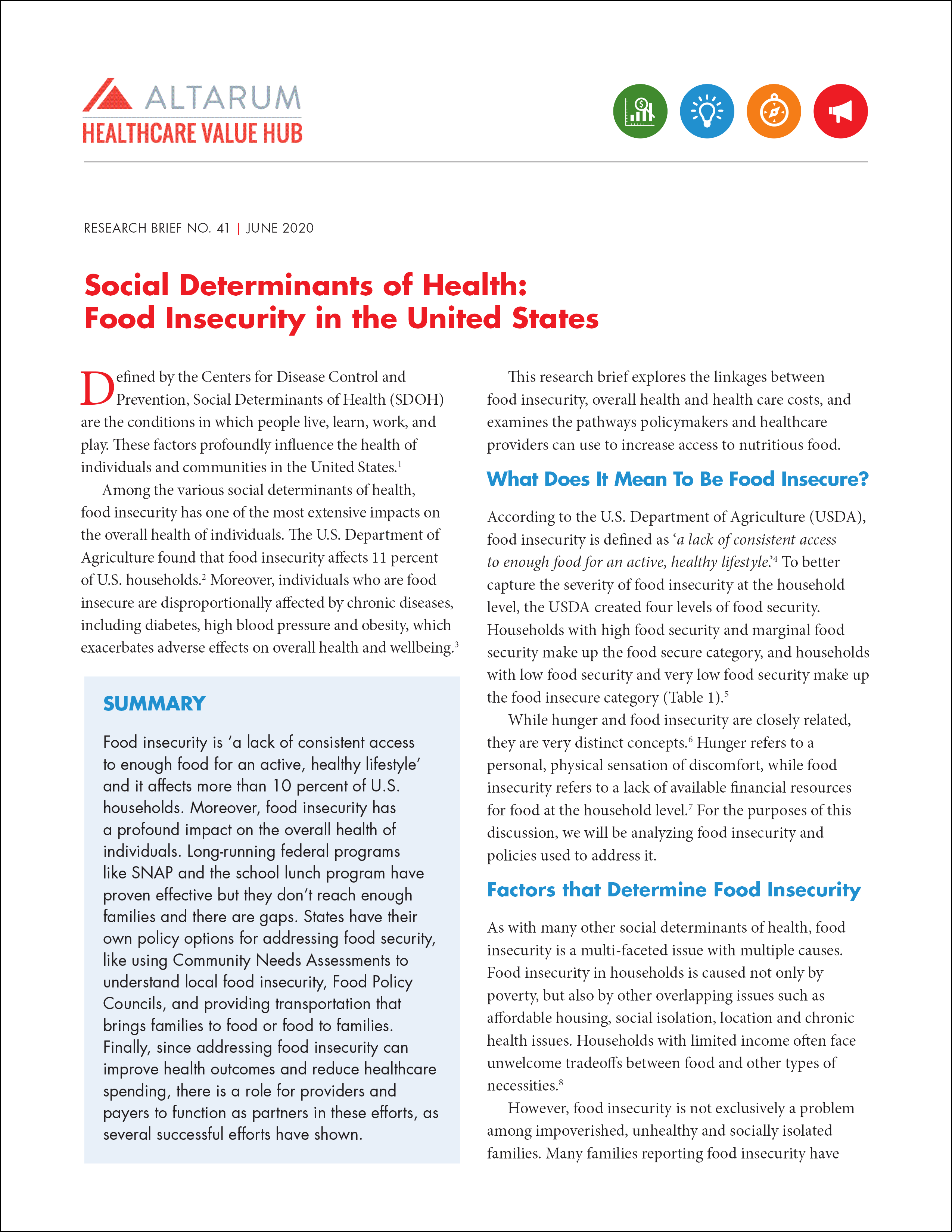Improving Value
Social Determinants of Health—Food Insecurity
Food insecurity has an extensive impact on the overall health of individuals. The U.S. Department of Agriculture found that food insecurity affects 11 percent of U.S. households.1 Moreover, individuals who are food insecure are disproportionately affected by chronic diseases, including diabetes, high blood pressure and obesity, which exacerbates adverse effects on overall health and wellbeing.2
According to the U.S. Department of Agriculture, food insecurity is defined as 'a lack of consistent access to enough food for an active, healthy lifestyle.'3 |
Factors Affecting Food Insecurity
Though poverty plays a role, it is not the sole reason why individuals and families may be food insecure. Overlapping issues such as affordable housing, social isolation, location and chronic health issues play a role in creating food insecure households. In addition, many families reporting food insecurity have incomes above the official poverty line, demonstrating that this is not solely a problem among low-income households.4
Additionally, both rural and urban communities face challenges when it comes to accessing healthy food. Food deserts—communities that lack retailers and stores that supply fresh, nutritious foods—exist in both settings.5,6 Indeed, about 23.5 million urban and rural Americans live in food deserts, with nearly half of them in low-income areas.7
The Centers for Disease Control and Prevention (CDC) define a food desert as an area that lacks access to affordable fruits, vegetables, whole grains, low fat milk and other foods that make up a healthy diet.8 |
Food insecurity affects approximately 11 percent of households in the U.S.—1 in 8 adults and 1 in 6 children live in households that are food insecure.9 These households report struggling to afford balanced meals and worrying that food will run out before they have the money to buy more.10
Role for Healthcare Payers and Providers
Food insecurity across the U.S. is correlated with increased prevalence of chronic health conditions.11 In a 2018 study, researchers found that the most common chronic conditions for adults facing food insecurity were diabetes, hypertension and arthritis.12 Not surprisingly, these chronic conditions lead to higher healthcare costs and utilization. Average healthcare costs for food-insecure adults were $1,834 higher than for food-secure adults.13 These additional costs include those from increased use of healthcare, such as clinic visits, hospitalizations and prescription medications.14
Because reducing food insecurity can improve health outcomes and reduce healthcare spending, there is a potential opportunity for healthcare payers and providers to realize savings from prevention. Programs tailored to specific types of patients could be particularly effective—for example, investments that reduce hypoglycemia-related hospitalizations for Type 1 diabetics could result in a net cost savings of between $946 to $1,346 per patient.15
What is the Federal Government Doing?
Formerly known as Food Stamps, the Supplemental Nutrition Assistance Program (SNAP) is the first line of defense against hunger and food insecurity in the U.S. SNAP participation has been shown to reduce food insecurity by 30 percent in some populations.16 Other studies show that SNAP benefits have positively impacted the overall health of children and reduced hunger.17 Moreover, unlike Medicaid where there is a sharp cliff in terms of income eligibility, SNAP provides a sliding scale of support based on an individual’s income.18
However, more than one-quarter of people who are food insecure are not eligible for SNAP, leaving them with few options for healthy food.19 Reasons for ineligibility include immigration status, income, student status and being a childless adult who works more than 20 hours per week (regardless of income).20 Expanding eligibility for SNAP, increasing benefit amounts and easing program access could increase food security for individuals and families. To address rural broadband access issues that can impact the ability to apply for SNAP,21 the U.S. Food and Nutrition Service provides state agencies with a Program Access Review Guide for their SNAP programs, though recommendations are voluntary.22
Other federal programs to combat food insecurity include:
- The Special Supplemental Nutrition Program for Women, Infants, and Children (WIC) – a public health nutrition program providing nutrition education, breastfeeding support and nutritious foods to low-income pregnant women and mothers of small children. WIC has a track record of cost-effectiveness and improvement in health outcomes.
- The National School Lunch Program (NSLP) – a program that provides 1-2 nutritious meals a day to students, depending on their family’s household income. Students at public and non-profit charter schools can receive nutritiously balanced lunches at little to no cost each day they are in school.
- The Summer Food Service Program – a program that provides free meals to kids and teens in low-income areas when school is out, since NSLP does not provide meals during the summer.
- The Child and Adult Food Program – a program serving preschools that are not a part of the NSLP.
What are States Doing?
States have their own policy options to address food insecurity, including tailoring their approaches to reflect local differences in rural vs. urban settings and supply side considerations like food deserts.
State levers include:
- Community Needs Assessments to understand food insecurity: Community needs assessments collect data on unmet community needs providing actionable information for their stakeholders.23 The CDC provides an extensive toolkit on how to conduct a community food needs assessment, which highlights states that have successfully completed these assessments.24
- Food Policy Councils: These councils operate at the state or local level and their activities typically include coordination of food actors, networking, information sharing and advocacy. Councils are commonly created by local, state or federal governments, but they can also be established by non-governmental agencies. Research conducted by the CDC and 25 state health departments shows that food policy councils can increase access to healthy foods.25
- Removing barriers to food donation through legislation: In 1996, President Clinton passed the Federal Bill Emerson Food Donation Act,26 which protected any person, gleaner or non-profit organization who donated food in good faith, and without gross negligence, from civil or criminal liability. Despite these protections, many restaurants and other institutions worry about the potential legal implications they could face for donating food. To address remaining worry about the potential legal implications for donating food, states can also provide protections, as California did upon passing the Good Samaritan Food Donation Act.27
- Providing reliable transportation to food banks or mobile food banks: Many individuals find it difficult or strenuous to make it to a brick-and-mortar food bank site. To increase accessibility, state Medicaid programs can repurpose non-emergency medical transport to cover transportation to and from food banks and soup kitchens. States can also consider bringing food to people using non-medical transport as the delivery mechanism. Although there are no Medicaid models with records of providing this type of service, various non-profit and other organizations provide food delivery services to specific vulnerable populations.28
For a more detailed discussion of food insecurity, see our Research Brief, No. 41, “Social Determinants of Health: Food Insecurity in the United States.”
Notes:
1. Coleman-Jensen, Alisha, et al., Household Food Insecurity in the United States in 2018, United States Department of Agriculture, Washington, D.C. (September 2019).
2. Feeding America, Impact of Hunger. (Accessed on March 1, 2020).
3. Feeding America, What is Food Insecurity? (Accessed on March 1, 2020).
4.Wight, Vanessa, et al., "Understanding the Link Between Poverty and Food Insecurity Among Children: Does the Definition of Poverty Matter?" Journal of Children and Poverty (2014).
5. Rural Health Information Hub, Rural Health and Access to Healthy Food. (Accessed on May 10, 2020).
6. Crowe, Jessica, et al., "Barriers to Food Security and Community Stress in an Urban Food Desert," Urban Science, Vol. 2, No. 2 (May 31, 2018).
7. United States Department of Agriculture, Definitions of Food Security.
8. Centers for Disease Control and Prevention, A Look Inside Food Deserts. (Accessed on March 1, 2020).
9. Coleman-Jensen, Alisha, et al. Household Food Insecurity in the United States in 2018, United States Department of Agriculture, Washington, D.C. (September 2019).
10. United States Department of Agriculture, Definitions of Food Security.
11. Seligman, Hilary, Barbara Laraja and Margot Kushel, "Food Insecurity is Associated with Chronic Disease Among Low-Income NHANES Participants," The Journal of Nutrition, Vol. 140, No. 2 (February 2010).
12. Garcia, Sandra, Anne Haddix and Kevin Barnett, Incremental Health Care Costs Associated with Food Insecurity and Chronic Conditions Among Older Adults, The Centers for Disease Control and Prevention, Atlanta, GA. (August 2018).
13. Artiga, Samantha, and Elizabeth Hinton, Beyond Health Care: The Role of Social Determinants in Promoting Health and Health Equity, Kaiser Family Foundation (May 2018).
14. Swartz, Haley, Visualizing State and County Healthcare Costs of Food Insecurity, Feeding America (Aug. 5, 2019).
15. Feeding America, Mobile Food Pantry Program, Washington, D.C.
16. Keith-Jennings, Brynne, Joseph Llobrera and Stacy Dean, "Links of the Supplemental Nutrition Assistance Program with Food Insecurity, Poverty and Health: Evidence and Potential," American Journal of Public Health, Vol. 109, No. 12 (December 2019).
17. Center for Budget and Policy Priorities, Chart Book: SNAP Helps Struggling Families Put Food on the Table. (Accessed May 11, 2020).
18. Dewey, Caitlin, "What Americans Get Wrong About Food Stamps, According to an Expert Who's Spent 2 Years Researching Them," The Washington Post (April 4, 2017).
19. Food Waste Reduction Alliance, Analysis of U.S. Food Waste Among Food Manufacturers, Retailers, and Restaurants, Arlington, VA (2014).
20. Center on Budget and Policy Priorities, Policy Basics: The Supplemental Nutrition Assistance Program (SNAP). (Accessed April 20, 2020).
21. Balbes, Maribelle, et al., State Level Program Access Review Guide, Food and Nutrition Service, USDA, Alexandria, VA (2012).
22. Ibid.
23. Healthcare Value Hub, Improving Value: Community Benefit and Community Health Needs Assessment, Washinton, D.C. (Accessed on June 8, 2020).
24. Centers for Disease Control and Prevention, Healthier Food Retail: Beginning the Assessment Process in Your State or Community, Atlanta, GA (2014).
25. Center for Disease Control and Prevention, DNPAO State Program Highlights Food Policy Councils, Atlanta, GA (May 2010).
26. Public Law 104-210, "Bill Emerson Food Donation Act." Passed October 1996.
27. Ibid.
28. California Law AB-1219, "California Good Samaritan Food Donation Act." Passed November 2017.
29. Feeding America, Mobile Food Pantry Program, Washington, D.C.







